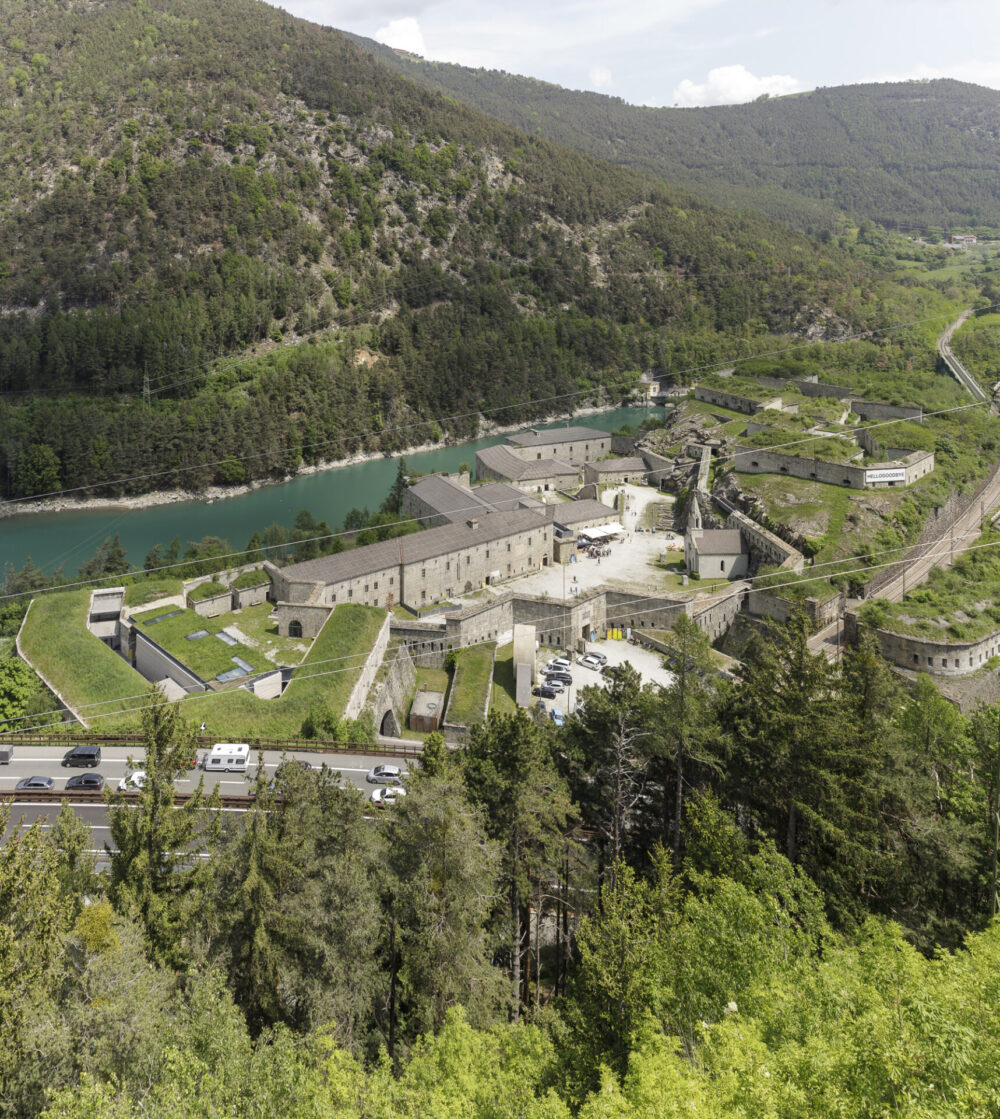Once an insurmountable dam, today a place of cultural exchange
With its 65,000 square metres of building space, Franzensfeste is the largest historical complex in South Tyrol. Begun in 1833 under Emperor Franz I, this masterpiece of Austrian military architecture was opened by Emperor Ferdinand I in 1838 after only five years of construction. However, by this time it had already lost its strategic importance and therefore its justification. The enormous effort and horrendous costs – for nothing. From then on, the huge fortress was only of use as a depot and remained dormant for over a century and a half as a closely guarded military installation.
When the military finally left the fortress in 2003, it was up to a group of courageous volunteers from Franzensfeste to clear the site of the vegetation that had grown in every nook and cranny and to remove the rubble and dust. The Franzensfeste Fortress has been open to the public since 2005 and was extensively, albeit cautiously, renovated in the course of hosting two major exhibitions, the European Art Biennale Manifesta7 in 2008 and the South Tyrolean Provincial Exhibition in 2009. Since then, it has been a popular venue for a wide variety of exhibition and event formats. In 2013, it became state property and has been the tenth and youngest provincial museum of the Autonomous Province of South Tyrol since January 2017.

A fortress the size of 9 football pitches
From 1801, the young Archduke Johann, brother of Emperor Franz I, was responsible for building fortifications in the Habsburg Empire. However, his recommendations to secure the most important passages and crossings from the Inn to the Po initially went unheeded. It was the July Revolution in Paris in 1830 that gave new impetus to the freedom and national movements in Europe. Austria had its hands full keeping the recurring uprisings in its multi-ethnic state under control, especially in its provinces of Lombardy and Veneto. As a result, the issue of fortress building once again attracted more attention at court and concrete plans for the fortification of the empire had to be drawn up as quickly as possible.
Following the Congress of Vienna in 1815, Austria, Prussia and around 30 small states joined forces to form the German Confederation with the aim of establishing a belt of fortifications along the Rhine and in northern Italy to ward off future attacks. Tyrol, as the westernmost crown land of the Habsburg Monarchy and the southernmost borderland of this German Confederation, was an important geographical transport and military-strategic axis between southern Germany and northern Italy.
Archduke Johann’s ideas now came into play. Franz von Scholl, who had already been appointed to expand the federal fortress in Mainz in 1824, was now also commissioned to expand the Habsburg fortress quadrangle of Verona-Mantua-Peschiera-Legnago, the so-called ‘Quadrilatero’. He was also tasked with planning an entrenched camp on the Natz-Schabser plateau, reinforced by a ring of additional fortifications around the Brixen basin, in order to hermetically seal off all surrounding valley connections against an enemy advance.
The work, which had already begun in 1833, was continued after the death of Franz I in 1835 despite the lack of funds. However, the gigantic project of the entrenched camp with additional fortifications in the Brixen area was buried. Inaugurated by Emperor Ferdinand I in August 1838 and christened the ‘Franzen Feste’ by Prince-Bishop Galura of Brixen, it remains a ‘lying lion’ waiting for its enemy to this day. The construction probably cost around three million guilders CM (Convention coin). This was probably incomprehensible to the inexperienced Emperor Ferdinand I, who is said to have asked during the inauguration whether the Franzensfeste was made of silver. Today, the monetary value would correspond to around 54 million euros, but the construction sum would be significantly higher.
A planning masterpiece
Optimum adaptation to the terrain, large firing fronts against the enemy, bomb-proof gun emplacements and shelters for men and material, separation of the individual fortifications by stairs or ramps, internal defences in which the fortifications could support each other, multiple protection of all outer gates and entrances, etc. However, no more money was authorised for the provision of military equipment. Although planned in detail time and again, no cannon in the original sense was installed. Only during the wars of 1848, 1859 and 1866 were there a few cannons behind the embrasures for a short time. However, they soon disappeared again and the originally planned artillery works degenerated into a depot because the guns were needed on the battlefields in the south.
Instead of 1,100 artillerymen and infantrymen, only a regular crew of 70 men were still on duty as guards and storekeepers. Time and again, companies from various regiments were billeted in its rooms to await deployment in the south. During the First World War, a military hospital was also set up in the Franzensfeste. An unmistakable sign of the fortress’s last use by the Italian military as a weapons and ammunition depot are the concrete-tiled roofs, which are covered with metal strips that reach down to the ground along the façades and served as lightning protection for the highly explosive ammunition according to the Faraday cage principle.
Even if the barrier did not have to fend off a military attacker, its powerful appearance often stood in the way of an ‘enemy’: progress. These include the construction of the Brenner Railway in 1864-1867, the construction of the Pustertal Railway in 1870/71, whose tracks were routed directly through the Franzensfeste, the construction of the dam wall, which created a lake for generating electricity in 1940, and the construction of the motorway in the early 1970s. All these interventions still have an impact on the original fortress today. For example, the reservoir repeatedly floods parts of the fortress and part of the complex had to be tunnelled under for the relocation of the main road.
A logistical challenge
All the building materials needed had to be brought in from all directions using ox and horse-drawn carts with a maximum payload of 800 kg each and a speed of 2 to 3 km/h. At peak times, around 200 carts delivered several hundred loads a day. At peak times, according to a theoretical extrapolation, around 200 carts delivered several hundred loads a day.
Due to the lack of modern construction machinery, a construction period of just five years could only be managed with a large workforce. Depending on the time of year, 3,500 to 5,000 men from all parts of the Habsburg Empire worked on the largest construction site in Europe at the time. For comparison: the town of Brixen had 3,000 inhabitants at the time, Sterzing and Bruneck less than 2,000. The labour army consisted mainly of ‘military handlers’ from the eastern provinces of the monarchy, supplemented by construction soldiers and civilian construction workers from Tyrol and Upper Italy. Most of them were housed in barrack camps between Aicha and Mittewald. Here too, sophisticated logistics had to ensure the supply of food and water.
The Franzensfeste was the witness and guardian of a treasure
On 16 December 1943, the fortress became the hoard of a huge treasure: 127.5 tonnes of Italian monetary gold in the form of bars and coins were stored in sealed barrels and boxes in an existing rock tunnel under the Mittlere Festung. Converted to today’s fine gold content (March 2020), this corresponds to a value of just over 4 billion euros. But the gold did not remain in the tunnel for long. By the time the German Wehrmacht surrendered in Italy on 3 May 1945, a total of 102.5 tonnes of gold had been removed. Two deliveries went to the German Reichsbank in Berlin ‘to finance the joint war effort’, while a third consignment ended up at two Swiss banks in Bern.
The 25 tonnes of gold remaining in the tunnel were confiscated by an American infantry unit in May and taken to Rome shortly afterwards.
A large part of the Italian gold was discovered by Americans in a Thuringian potash mine in April 1945 and immediately brought to Frankfurt am Main in a lightning operation. The search for the eight tonnes of gold coins that Reich Foreign Minister Ribbentrop had ‘diverted’ from the first gold shipment to Berlin was somewhat more protracted. However, by June 1945 at the latest, the Allies were able to seize this gold at various locations in northern Germany and Austria. Now well documented, documents that could not be found for a long time and locked archives gave rise to the most adventurous stories.
The fortress as an experience space
There are, for example, the casemates with their granite walls, brick vaults and wooden floors. Or the fortress chapel, which was only added in 1844 and whose neo-Gothic style forms an interesting contrast to the functional ‘military classicism’ of the other fortress buildings. A steep underground staircase with 452 steps leads up to the 90 metre higher Franzensfeste Fortress (Upper Fortress). Unique in Europe and always a physical challenge for visitors. An officers’ mess, with a dining room richly decorated with wall frescoes, where guests can experience a bit of “Habsburg officer’s splendour”. Then a small obelisk, one of seven in the empire at the time and the only one that stood in German-speaking Austria until 1920. A main measuring point that marks the exact local altitude of 736.4520 metres and was regarded as the original marker from which the Habsburg Empire was further measured.
